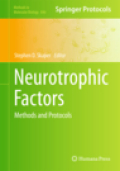
Nervous system development evolves from the well-orchestrated processes of neural induction, cell proliferation, differentiation, cell migration, survival,and synapse formation. Among these environmental cues, neurotrophic factors are secreted proteins that promote neurite outgrowth, neuronal cell differentiation and survival both in vivo and in vitro. Nerve growth factor (NGF) is the founding and best characterized member of the neurotrophin family of neurotrophic polypeptides. Neurotrophic Factors: Methods and Protocols presents a selection of protocols and procedures which make use of cellular, tissue, and wholeanimal models which can be applied to the investigation of neurotrophic factors and other agents impacting on these systems. Chapters cover a wide-range oftopics such as dealing with the culture of neurons and glia from the central and peripheral nervous systems, neuron-glia co-culture models, and cell-based assays for the evaluation of neuroprotective molecules, as well as assays which can be applied to the study of agents with neuroregenerative potential. Protocols describing viral- and nanoparticle-based delivery methods to neural cells are also presented, following by chapters dealing with organotypic slice culture protocols. Lastly, several chapters are dedicated to in vivo lesion models of relevance to nervous system pathology, which can be applied to the investigation of neurotrophic factors and peptides. Written in the successful Methods in Molecular Biology™ series format, chapters include introductions to theirrespective topics, lists of the necessary materials and reagents, step-by-step, readily reproducible protocols, and notes on troubleshooting and avoiding known pitfalls. . Authoritative and easily accessible, Neurotrophic Factors: Methods and Protocols seeks to serve both professionals and novices alike with its well-honed methodologies in an effort to further our knowledge of what hasbeen described as the last frontier of science. Includes cutting-edge methods and protocols. Provides step-by-step detail essential for reproducible results. Contains key notes and implementation advice from the experts. INDICE: The Neurotrophin Family of Neurotrophic Factors - An Overview. Neuronal Growth-Promoting and Inhibiting Cues in Neuroprotection and Neurodegeneration. Culture of Rat Cerebellar Granule Neurons and Application to Identify Neuroprotective Agents. Isolation and Culture of Neural Progenitor Cells from Rat Postnatal Cerebellum. Culture of Rodent Cortical and Hippocampal Neurons. Amyloid ?-Peptide Neurotoxicity Assay Using Cultured Rat Cortical Neurons. Culture of Neonatal Rodent Microglia, Astrocytes, and Oligodendrocytes from Cortexand Spinal Cord. Central Nervous System Neuron-Glia Co-Culture Models. Culture and Characterization of Rat Mesencephalic Dopaminergic Neurons. Preparation of Adult Spinal Cord Motor Neuron Cultures Under Serum-Free Conditions. RodentRetinal Ganglion Cell Cultures. Culture of Purified Glial Cell Populations from Optic Nerve. Isolation and Culture of Rat Cone Photoreceptor Cells. Rat Retina Pigmented Epithelial Cells. Mammalian Growth Cone Turning Assays Identify Distinct Cell Signalling Mechanisms that Underlie Axon Growth, Guidance and Regeneration. Culture of Dissociated Sensory Neurons from Dorsal Root Ganglia ofPostnatal and Adult Rats. Culture and Proliferation of Highly Purified Adult Schwann Cells from Rat, Dog, and Man. Use of PC12 Cells and Rat Superior Cervical Ganglion Sympathetic Neurons as Models for Neuroprotective Assays Relevantto Parkinson’s Disease. Compartmented Chambers for Studying Neurotrophic Factor Action. Preparation and Culture of Adrenal Chromaffin Cells. Indirect Immunofluorescence Staining of Cultured Neural Cells. Neurite Outgrowth Assessment Using High Content Analysis Methodology. Dissociated Cell Culture for Testing Effects of Carbon Nanotubes on Neuronal Growth. High-Resolution Imaging and Evaluation of Spines in Organotypic Hippocampal Slice Cultures. Imaging Amyloid Precursor Protein In Vivo - An Axonal Transport Assay. The Use of Specific AAVSerotypes to Stably Transduce Primary CNS Neuron Cultures. Preparation and Characterization of Biocompatible Chitosan Nanoparticles for Targeted Brain Delivery of Peptides.- [3H]Serotonin Release Assay Using Antigen-Stimulated Rat Peritoneal Mast Cells. Rat Hippocampal Slice Culture Models for the Evaluationof Neuroprotective Agents. A 6-Hydroxydopamine In Vivo Model of Parkinson’s Disease. Brain Microdialysis in Freely Moving Animals. Evaluating Motor Neuron Death in Neonatal Rats Subjected to Sciatic Nerve Lesion. Rodent Spinal Cord Injury Model and Application of Neurotrophic Factors for Neuroprotection.
- ISBN: 978-1-61779-535-0
- Editorial: Humana Press
- Encuadernacion: Cartoné
- Páginas: 474
- Fecha Publicación: 28/02/2012
- Nº Volúmenes: 1
- Idioma: Inglés
